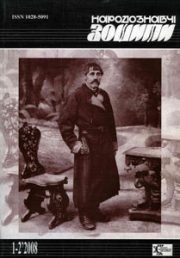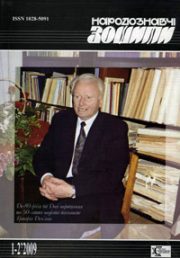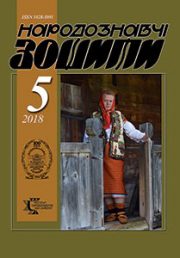The Ethnology Notebooks. 2021. № 5 (161), 1174—1183
UDK 930.2:[[398.31:392.5]:[398.332.2+398.332.4]](477)”18″
DOI https://doi.org/10.15407/nz2021.05.1174
SEREBRYAKOVA Olena
- ORCID ID: https://orcid.org/0000-0002-1039-2920
- candidate of Historical Sciences (= Ph.D. in history),
- research worker of the department of the modern ethnology
- of the Ethnology Institute
- of the National Academy of Sciences of Ukraine,
- 15, Svobody Avenue, 79000, Lviv, Ukraine,
- Contacts: e-mail: o-sereb@ukr.net
Abstract. Folk divination is an important component of the ancient and traditional culture of Ukrainians in particular of calendar ritualism.
The aim of the offered article is coverage of the layer of custom and ritual and worldview phenomena associated with the divination about the marriage with wreaths.
The object of the research is the traditional world view and the custom and rite culture of the inhabitants of Ukraine, and the subject — the marriage mantic ritual actions with wreaths during summer and winter calendar holidays. The basis for the article are the materials of the field research, local folklore articles and works of the nineteenth and the beginning of the twenty-first centuries.
The methodology of this work is based on general scientific methodological principles and the basic requirements that apply to the works of historical and ethnological direction. The author uses a various methods (field observation, comparative-historical, comparative, reconstructive, structural-semantic and method of cross-cultural comparisons).
Mantic traditions (putting wreaths on the water, roof; thro wing on trees; catching from the water), local beliefs, signs, customary prescriptions, warnings, ritual prohibitions, boys’ roistering related to the prediction of the time of the expected marriage, the appearance of the future husband etc. in the fortune telling during the summer and winter calendar cycles of holidays of the inhabitants of different regions of Ukraine are analyzed. The functionality, semantics, symbolism of attributes, modifications divination and also degree of preservation of investigated phenomena in modern time are revealed. Most of them are mantic actions performed by girls, rarely guys or all together.
Keywords: mantic actions/practices (divination), Ukrainians, wreaths, water, candle, straw, trees, marriage.
Received 7.09.2021
REFERENCES
- Serebriakova, O. (2011).OnMantic actions with wreaths in Ukrainians’ Midsummer day rites. Calendar ritualism in the life of the ethnos: collection of scientific works: materials of the International Scientific Conference «Odesa Ethnographic Readings» (Pp. 287—296). Odesa [in Ukrainian].
- Serebriakova, O. (2015).On ritual symbolism and functions of Midsummer day wreaths in Cherkasy region: aspect of mantic-magic. The Ethnology notebooks, 2 (122), 450—456 [in Ukrainian].
- Serebriakova, O. (2019). Symbolic and functional peculiarities of plants in the hydromantic actions of the inhabitants of Pokuttia (fragments of winter and summer rituals). The Ethnology notebooks, 2 (146), 423—429 [in Ukrainian].
- Vynohradova, L.N. (1981). Maiden’s fortune-telling about marriage in the cycle of the Slavic calendar rituals (West-East Slavic parallels). Slavianskyj y balkanskyj fol’klor. Obriad. Tekst (Pp. 13—43). Moskva: Nauka [in Russian].
- Dmitrieva, S.I. (1988). Folklore and folk art of Russians of the European North. Moskva: Nauka [in Russian].
- Tokarev, S. (Ed.). (1978). Calendar customs and ceremonies in countries of foreign Europe. Summer and autumn holidays. Moscow: Nauka [in Russian].
- Nekrylova, A.F. (Ed.). (1991). All year round. Russian agricultural calendar. Moskva: Pravda [in Russian].
- Moysey, A.A. (2010). Agrarian customs and ordinances in the folk calendar of the East-Romanian population of Bukovina. Chernivtsi [in Ukrainian].
- Sokolova, V.K. (1987). Calendar holidays and rituals. Ethnography of the Eastern Slavs: Essays of traditional culture (Pp. 380—395). Moskva: Nauka [in Russian].
- Janulajtis, A. (1906). Lithuanian superstitions and omens. Zhivaja starina (Issue IV, pp. 189—201). Sankt-Peterburg [in Russian].
- Marczak, K. 1991. Polish customs. Rotam, 2, 36 [in Polish].
- Archive of the IN NANU (Archive of the Institute of Ethnology of the National Academy of Sciences of Ukraine). F. 1. Op. 2. Od. save 337. Arc. 12—19 [in Ukrainian].
- Archive of the IN NANU. F. 1. Op. 2. Od. save 533. Arc. 1—183 [in Ukrainian].
- Archive of the IN NANU. F. 1. Op. 2. Od. save 550. Arc. 1—205 [in Ukrainian].
- Archive of the IN NANU. F. 1. Op. 2. Od. save 587. Arc. 1—74 [in Ukrainian].
- Archive of the IN NANU. F. 1. Op. 2. Od. save 588. Arc. 1—121 [in Ukrainian].
- Archive of the IN NANU. F. 1. Op. 2. Od. save 594. Arc. 1—143 [in Ukrainian].
- Archive of the IN NANU. F. 1. Op. 2. Od. save 607. Arc. 1—100 [in Ukrainian].
- Archive of the IN NANU. F. 1. Op. 2. Od. save 608. Arc. 1—354 [in Ukrainian].
- Archive of the IN NANU. F. 1. Op. 2. Od. save 609. Arc. 1—65 [in Ukrainian].
- Archive of the IN NANU. F. 1. Op. 2. Od. save 663. Arc. 1—67 [in Ukrainian].
- Archive of the IN NANU. F. 1. Op. 2. Od. save 704. Arc. 1—489 [in Ukrainian].
- Varkhol, J. (2019). Calendar and family ritualism of Ukrainians in Slovakia. Kyiv: IMFE im. M.T. Ryl’s’koho NAN Ukrainy [in Ukrainian].
- Voznyak, V. (2003). My village — Ukraine’s blossom. Ivano-Frankivsk: Nova Zorya [in Ukrainian].
- Kostenko, L. (2011). Trinity and Kupala plant attributes of the Left-Shore Polissya. Calendar ritualism in the life of the ethnos: collection of scientific works: materials of the International Scientific Conference «Odesa Ethnographic Readings» (Pp. 183—194). Odesa [in Ukrainian].
- Archive of the IN NANU. F. 1. Op. 2. Od. save 590. Arc. 1—48 [in Ukrainian].
- Archive of the IN NANU. F. 1. Op. 2. Od. save 787. Arc. 1—200 [in Ukrainian].
- NANF IMFE NAN of Ukraine (National archival scientific collections of manuscripts and audio recordings of M.T. Rylsky Institute of Art Studies, Folklore and Ethnology of the National Academy of Sciences of Ukraine). F. 14—5. Act. 556. Arc. 1—90 [in Ukrainian].
- NANF IMFE NAN of Ukraine. F. 14—5. Act. 604. Arc. 1—23 [in Ukrainian].
- NANF IMFE NAN of Ukraine. F. 14—5. Act. 667. Arc. 1—32 [in Ukrainian].
- Vasilechko, L. (1994). Shutkov’s Sunday. People’s customs, ceremonies and beliefs. Broshniv: Talya [in Ukrainian].
- Petrova, N. (2011). Calendar ritualism of Ukrainians of Mykolayiv district of Odesa region in the middle of the XX century: new field materials. Calendar ritualism in the life of the ethnos: collection of scientific works: materials of the International Scientific Conference «Odesa Ethnographic Readings» (Pp. 267—278). Odesa [in Ukrainian].
- Halajchuk, V. (2019). Folk calendar of Bereznivschyna in rites, customs and folklore. The Ethnology notebooks, 4 (148), 951—1000 [in Ukrainian].
- Archive of the IN NANU. F. 1. Op. 2. Od. save 701. Arc. 1—104 [in Ukrainian].
- Archive of the IN NANU. F. 1. Op. 2. Od. save 513. Arc. 1—73 [in Ukrainian].
- Halajchuk, V. (2010). Traditional calendar customs and rites of the Old Sambir region. Notes of the Shevchenko Scientific Society (Vol. CCLIX, pp. 138—179) [in Ukrainian].
- Marusyk, P. (2000). Bellevue, my cradle: History, ethnography, life. Halych [in Ukrainian].
- Archive of the IN NANU. F. 1. Op. 2. Od. save 239 d. Arc. 1—83 [in Ukrainian].
- Khomyk, V. (1963). Lemko’s customs and rites. Nashe slovo, 21, 5 [in Ukrainian].
- Maksymovych, M. (2002). Days and months of the Ukrainian peasant. Kyiv: Oberehy [in Ukrainian].
- Archive of the IN NANU. F. 1. Op. 2. Od. save 521. Arc. 1—46 [in Ukrainian].
- NANF IMFE NAN of Ukraine. F. 14—5. Act. 675. Arc. 1—25 [in Ukrainian].
- Voropay, O. (1966). Customs of our people. Ethnographic essay (Vol. 2). Miunkhen [in Ukrainian].
- Domanytskyy, V. (1912). People’s kalendаr in the Rovno County, Volyn Guberniya. Materials for Ukrainian Ethnology (Vol. XV, pp. 62—89).Lviv [in Ukrainian].
- Chubinskij, P.P. (1872). Folk diary. Proceedings of the ethnographic-statistical expedition to the Western Russian region, equipped by the Imperial Russian Geographical Society: materials and research collected by P.P. Chubinsky (Vol. 3). Sankt-Peterburg [in Russian].
- Kryms’kyj, A.Yu. (2009). Zvenigorod region. Shevchenko’s homeland from the point of view of ethnographic and dialectological: reproduction from the author’s model of 1930. Cherkasy: Vertykal’, vydavets’ PP Kandych S.H. [in Ukrainian].
- Archive of the IN NANU. F. 1. Op. 2. Od. save 304. Arc. 90—112 [in Ukrainian].
- Hrebeniak, I. (1976). Skole. Chronicle of Boykivshchyna. Sambir (Part 1/23, pp. 14—25) [in Ukrainian].
- Archive of the IN NANU. F. 1. Op. 2. Od. save 281. Arc. 1—62 [in Ukrainian].
- Petretskyj, V. (1930). Christmas customs and rites in Turia Bystra. Subcarpathian Russia (Part 1—2, pp. 21—22). Uzhhorod [in Ukrainian].
- Mashkarynets’, V. (1930). Beliefs on some holidays in the village of Kalnyk. Subcarpathian Russia (Part 1—2, pp. 22—25). Uzhhorod [in Ukrainian].
- NANF IMFE NAN of Ukraine. F. 14—5. Act. 50. Arc. 1—140 [in Ukrainian].
- Archive of the IN NANU. F. 1. Op. 2. Od. save 658. Arc. 1—173 [in Ukrainian].
- Kukuch, A. (1930). Customs and beliefs in Yvra-Darma. Subcarpathian Russia (Part 1—2, pp. 15—16). Uzhhorod [in Ukrainian].
- Varkhol, J. (2001). Youth parties. Scientific collection of the Museum of Ukrainian-Russian Culture in Svidnik (Vol. 22, pp. 237—262). Priashiv [in Ukrainian].
- Pan’kevych, I. (1929). Christmas superstitions in our people. Subcarpathian Russia (Part 3, pp. 65—67). Uzhhorod [in Ukrainian].







